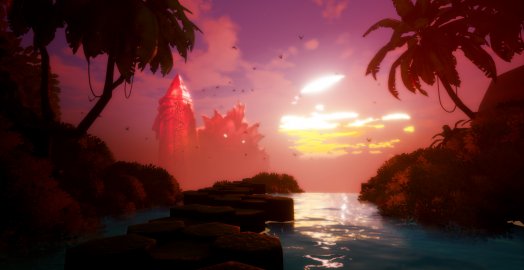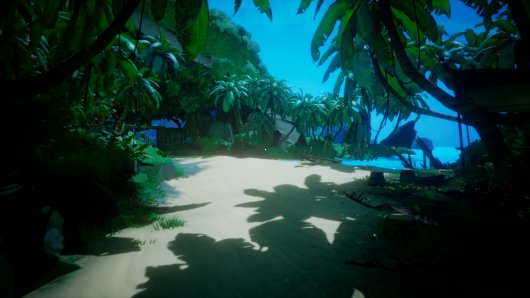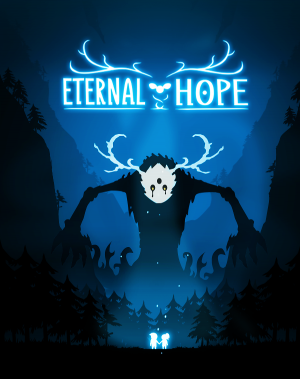Review for Call of the Sea

How far would you go to save someone you love? That’s the question threaded throughout Call of the Sea, a decidedly assured debut from Spanish-based developer Out of the Blue. This first-person 3D adventure whisks players away to a tropical South Pacific island in the pursuit of a missing spouse, but soon becomes a supernatural tale about self-discovery too. While the story unravels its mysteries at a curiously quick pace, taking inspiration from weird fiction writer H.P. Lovecraft and conjuring thoughts of aquatic romance film The Shape of Water, it’s a fun ride throughout, aided by its incredibly gorgeous visuals and satisfyingly brain-squirming puzzles.
Set in the 1930s, the game puts you in the role of Norah Everhart. Despite suffering from an unnamed illness that, amongst other symptoms, manifests itself through marks on her hands and causes strange recurring dreams taking place underwater, Norah remains spirited and determined. Her husband Harry ventured on an expedition to Tahiti a year ago to seek a cure, but eventually he stopped sending letters. When a mysterious package turns up on Norah’s doorstep containing a picture of Harry and an ancient relic, she decides to pick up his trail to find out what happened to him.
In clichéd fashion, Norah is advised to be careful on the unnamed island because of what the legends say about it (the captain of the boat that drops you off nearby doesn’t elaborate), but you’ll pay no heed to the warning. Intriguingly, as Norah approaches the island, she recognises it from in her dreams. Upon your arrival, you’ll find a place rich with history – despite seemingly being long-deserted, an ancient Polynesian civilization has left its enduring mark with ornaments, statues, and mechanical structures. Before long, however, it also becomes clear that some very different inhabitants once lived there as well, and perhaps still do: ghoulish figures briefly flash in Norah’s mind, a sludgy black ooze pours from the walls, and murals speak of other realities that don’t follow earthly physics or laws. While this isn’t a horror game by any means, these elements are unsettling, especially as Norah’s underwater dreams begin to blend with reality. Precisely what significance this land holds and how it relates to Norah is something for you to discover as you progress through its diverse biomes.
Then again, you might figure out where it’s all going from the opening cutscene. Call of the Sea is oddly keen to reveal its secrets in a way that makes the slightly pulpy story not as surprising as it could have been, though the finale offers a welcome injection of player agency. I don’t consider this a major fault, since guiding Norah along her journey is so entertaining and I appreciated the themes of acceptance and identity explored along the way, but it does mean the narrative isn’t as compelling as in other games with similarly personal stories. If certain story elements had been held back until later, or at least hinted at more subtly, the tale would have been more gripping and made for some more shocking reveals. As it stands, you’ll likely always be one step ahead of Norah.
This is a solitary adventure as you follow in the footsteps of Harry and his crew. Handily, they left behind lots of letters, photographs, and recordings that detail their findings and feelings. You will need to overlook the contrivance of these storytelling devices; they are researchers, so of course they would be documenting, but much of it isn’t exactly nuanced or believable – the sort of stuff where a note trails off because the writer feels unwell. Norah is also quite fond of unnaturally voicing on-the-nose exposition. The game tries its best to paint a picture of Harry’s companions, but there’s only so much you can learn from examining their belongings – the most you’ll establish are loose archetypes – which means that I never really felt any connection with them or shared Norah’s concern about their fates.
Despite the straightforward nature of the overarching story, the central relationship between Norah and Harry is portrayed well. These are two strong, driven individuals who have a deep love and respect for one another, and they are shown to be intellectual equals, as demonstrated through the work Harry left behind – while he has built wonderous contraptions, he is confident she can decode and master their functions. Harry’s mission was purely in pursuit of curing his ailing wife, his own safety be damned, and that unconditional love is expressed nicely in the letters he writes (voiced convincingly by Yuri Lowenthal) and the backstory Norah provides. You get a real sense for the type of man Harry is this way; since you’re following his trail, his presence is always felt, even though it’s not a physical one.
Norah is brought to life by Cissy Jones, whom you might recognise from Firewatch or The Walking Dead. She does a commendable job of carrying the game almost singlehandedly, expertly capturing the refined tones of a well-to-do 1930s woman. It’s a performance that makes you feel invested in the protagonist’s story thanks to the authentic emotions conveyed: her joy at finding a photo of Harry or concern when opening an empty weapons crate, for example. The pauses, laughs, and sighs all add to this believability. That said, while the delivery is near-faultless, the same can’t always be said for the direction. On more than one occasion, Norah will find something upsetting or shocking, only to be perfectly composed moments later. Sometimes she doesn’t react at all, with her silence feeling more like an oversight than an intentional choice.
Norah’s ultimate aim is to progress deeper into the island in search of her missing husband, but there’s always an obstacle in the way, whether it’s a drawbridge or a huge imposing stone doorway. These are often overcome by utilising the contraptions that Harry and his crew left behind – though you’ll need to figure out how they work first – which blend clever mechanics with the unusual physics and rules of the island itself. That means you’ll need to carefully examine everything you come across, be it Harry’s research, wall murals, ancient totems, and so on. Everything helpful will automatically be stored in Norah’s notebook, which you can refer to at any time (and you’ll need to do so liberally).
Each of the six chapters breaks its main puzzle into multiple smaller layers, like piecing together a torn page or repeating a musical tune. These all cleverly build upon one another, so you never feel overwhelmed or unfocussed, but eventually you’ll be using everything you’ve learnt to crack the final lock of that area. For example, one section combines your discoveries about electromagnetic waves, the sea level, and piano notes in order to understand the meaning of a forgotten language. While that sounds convoluted, it’s entirely logical in context. The difficulty curve is nicely measured, and by the end of each chapter you’ll feel very satisfied with yourself. While most of the puzzles are brain-tingling fun, there are a couple that are poorly communicated and some helpful hints from Norah wouldn’t have gone amiss. One puzzle I even completed by accident and I’m still unsure how I was meant to solve it.
Every step of the way, there’s no doubt about it: Call of the Sea is incredibly beautiful. As you first sail up to the island, with the impossibly blue water lapping around you, lush vegetation branching off at all angles, and colourful birds flying through the sky, it’s paradisiacal. After walking across the sun-drenched sand and into the jungle, very little light filters through the branches to create a slightly claustrophobic air. I often found myself standing in place, just taking in my surroundings. Not only is it graphically impressive, with high resolution and detailed textures, it’s a world that is fully realised. As you stumble across one of Harry’s workbenches, with books, jars and trinkets strewn everywhere, it feels like a place that has been lived in. And all around Norah, the often-majestic structures dwarf her, which really helps bring a sense of scale to the island setting.
What’s also impressive is the diversity of environments, as no two areas ever look the same. Though you begin in the jungle, the island has much more to offer. One of the early chapters takes Norah to a shipwreck, where thunder roars above and lightning reflects off the huge vessel and the imposing cliffs nearby, while overhead wires flap in the wind and dust kicks at your feet. It’s astoundingly atmospheric and is just one example of the continuing joy of arriving at a new location and exploring every nook and cranny. Norah even spends some time underwater, which is fantastically realised, feeling wonderfully alien and enchanting without ever needing to worry about running out of oxygen. The coral glows, brightly coloured fish swim past, and kelp rises and sways from the seabed. These scenes have deep meaning for Norah and you can understand why, even on a purely visual level.
That same level of care and attention has been paid to the audio. Key moments of discovery are punctuated with orchestral music, with grand rising themes that lend an air of the magical and mysterious. And whether it’s the rushing of wind or the chirping of birds, there’s always some background noise to provide ambiance. Even smaller details like the changing sound of your footsteps on different surfaces help add to the immersion. In one chapter, I particularly liked listening to the rain pouring down, only for it to turn muffled when I took shelter inside a waterfall-covered cave.
You directly control Norah from a first-person perspective, rarely seeing her arms and hands except in specific moments like climbing a ladder. You can use either a mouse and keyboard or a controller – I opted for the former, with the WASD keys handling movement and the mouse controlling the camera. Unfortunately, I did suffer a bit of motion sickness initially, but gratefully the developers released an update a few weeks after launch that resolved this, offering the ability to disable things like head bobbing and motion blur.
Even with this improvement, however, the actual movement still leaves a lot to be desired. The issue is that Norah moves at such a sluggish pace. When you first land on the island, she comments that she feels sprightly and able to run. At first I wasn’t sure if I was pressing the run button, since the additional speed boost is marginal. It’s not always a big problem, especially because the environments are so glorious to look at, but particular chapters are quite large, and if you haven’t figured out how to solve a puzzle or have accidentally passed over a clue, you can expect a lot of tedious back and forth. A bit of extra pep in the protagonist’s step would have been nice.
As Norah’s adventure draws near to its conclusion, our intrepid explorer comments that it feels like she’s been on the island for years. Indeed, despite its five-hour runtime, Call of the Sea seems longer in the best way possible. The environmental design is fantastic, constantly pulling you into beautiful new locations that feel epic and expansive. The puzzles are equally varied, with new mechanics introduced often without upsetting the established logic. While the story is entertaining enough, it isn’t thrilling – in part because the game plays its hand too early – and a couple of confusing puzzles aren’t helped by Norah’s slow movement. Nevertheless, this is an excellent experience overall that isn’t held back much by its few flaws. If the thought of a scenic island getaway with some great brain-teasing fun appeals to you, come on in, the water’s great.
WHERE CAN I DOWNLOAD Call of the Sea
Call of the Sea is available at:
- GOG -60%
- Steam
- HumbleBundle



_capsule_fog__medium.png)






















